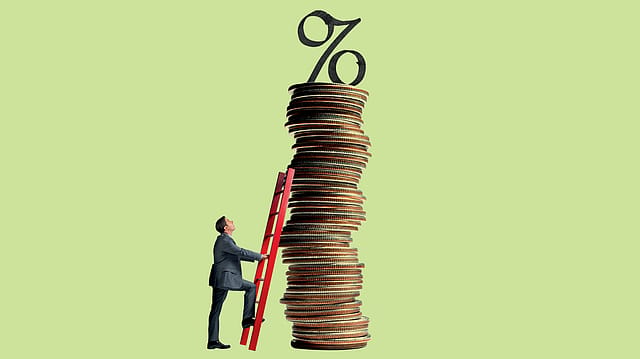Indian households, govt amass debt while India Inc. avoids loan trap
ADVERTISEMENT

Indians are loading up more debt. Not only Indian households but government debt too rose in the last five years.
Indian household core debt has gone up by 1 percentage point and rose from 34.5% of GDP to 35.5% of GDP between 2017 and June 2022. Though Indian households are loading up debt, they are relatively in better shape than households in advanced and emerging market economies. The household debt in advanced economies is 73.7% of GDP, while Indian household debt is almost half of it. Even the household debt in G-20 and emerging market economies with 57.6% and 45.8% of GDP are respectively higher than India’s household debt. These debt figures are expressed after converting USD at Purchasing Power Parity (PPP) exchange rates.
In the same period, the debt of the Indian government went up from 69.5% of GDP to a worrisome 82.4% of GDP. In absolute terms, the government debt has gone up from $1.8 trillion to $2.6 trillion, while for households it zoomed from $898 billion to $1.12 trillion in the last 5 years.
Due to the rising debt in both categories, risks are now at more elevated levels in India. Foreign Institutional Investors (FIIs) are a bit jittery on the back of rising debt and sold Indian equities worth over ₹1.21 lakh crore in 2022, as per NSDL (National Securities Depository Limited) data. Even in the first half of January 2023, FIIs have sold equities worth ₹18,808 crore. For FIIs, debt dynamics play a key role in ascertaining investment decisions as India is primarily a net importer and rising debt along with inflation impacts currency as well as government macro policy.
January 2026
Netflix, which has been in India for a decade, has successfully struck a balance between high-class premium content and pricing that attracts a range of customers. Find out how the U.S. streaming giant evolved in India, plus an exclusive interview with CEO Ted Sarandos. Also read about the Best Investments for 2026, and how rising growth and easing inflation will come in handy for finance minister Nirmala Sitharaman as she prepares Budget 2026.
The good news for India is a decrease in the core debt of the private non-financial sector which has reduced from 92.8% of GDP to 87.8% of GDP between 2017 and June 2022. The decline is purely on account of the reduction in debt levels of non-financial private corporations that came down to 52.3% of GDP from 58.3% of GDP.
The decrease in the core debt level of Non-Financial Corporate hints at deleveraging exercises by major companies as well as the lack of CAPEX undertaken by India Inc.
According to the Bureau of International Settlement (BIS), the core debt of the Indian Non-Financial Sector as a whole has gone up from 162.3% of GDP to 170.3% of GDP between 2017 and June 2022. Non-Financial Sector debt is the sum of household, government, and private non-financial corporate debt. Rising household and government debt led to the rise of core debt in the Indian Non-Financial Sector.
GLOBAL OUTLOOK ON DEBT
Governments across geographies have piled up debt in the last five years. In nominal value, the government debt on all reporting economies has gone up from $59.95 trillion to $79.62 trillion between 2017 and June 2022. In the same period, the US government debt level has gone up from $18.86 trillion to $27.74 trillion.
Total credit to the Non-Financial Sector of all reporting economies has gone up from $180.9 trillion to $221.9 trillion between 2017 and June 2022. Out of the $41 trillion rise, the bulk of debt of $15.53 trillion is on account of the US where debt levels rose to $64.47 trillion from $48.94 trillion. Similarly, China also witnessed a debt explosion of $19.2 trillion where the debt level of the Non-Financial Sector rose from $32.69 trillion to $51.87 trillion. For emerging market economies, the core debt of the Non-Financial Sector has gone up from $56.39 trillion to $81 trillion.
Total credit to Non-Financial Corporations (NFC) of all reporting companies has gone up from $71.56 trillion to $87.38 trillion. For emerging market economies it has gone up from $30 trillion to $40 trillion. Out of this $10 trillion rise, the bulk of NFC debt of $7.92 trillion is on account of China where the debt level rose to $27.88 trillion from $19.96 trillion.
In the NFC category, the US with $19.45 trillion has the second highest level of debt among the BIS reporting countries. Globally, both China and the US account for 54% of total NFC debt collectively. India’s Non-Financial Corporate debt stood at $1.65 trillion at the end of June 2022 whereas, in 2017 it was $1.51 trillion.
The maximum threshold level identified by the BIS for NFC debt stands at 90% of GDP while it is 85% for Household debt. The BIS considers debt above these levels to be a drag on future growth.
